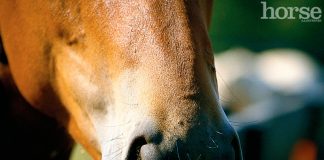If there’s anyone out there who knows the top feeding questions horse owners ask again and again, it’s feed company nutritionists. They’re in touch with everyone from big show barn managers to home caretakers of one horse—and get the same questions commonly from both. Here, some of the industry’s top experts offer their tried and true advice.

Q: Do I need to feed my aging senior horse differently than when he was younger and more active?
Senior horses may require a different feeding program due to changes in their teeth that impact ability to chew forages (hay and grass) and their ability to absorb nutrients.
These changes occur at different ages for different horses. You need to monitor his body condition score and also pay attention to muscle mass, hair coat and hoof quality. If you see problems, switching to a feed designed for senior horses can restore body condition, muscle mass and overall performance. It’s now common for senior horses to be ridden and compete very actively for many years.
Q: Is it OK to feed a straight grain (such as corn, oats or barley) as opposed to a formulated grain mix?
Roy A. Johnson: Straight grains are a good energy source and ingredient in feeds, but may not provide the amino acids, vitamins and minerals needed to balance the diet that are found in an equine-specific concentrate feed.
If you are using a straight grain, there are generally advantages to using a ration balancer as well, and perhaps offering appropriate minerals. Salt also needs to be available free choice.

Expert: Eric Haydt, Senior Vice President of Business Development for Triple Crown, Registered Animal Scientist
Q: My easy keeper only gets a handful of grain at feeding time. Is he getting all the nutrients needed?
If you feed a bagged concentrate, you do it primarily for three reasons: supplemental protein, supplemental calories (and not all horses need supplemental protein or calories), and key vitamins and minerals that all horses need. In a case where you have an easy keeper, you don’t need extra protein and calories, but you do want vitamins and minerals, regardless of if that horse is working hard or not doing anything. In these cases, a ration balancer is what’s required.
All feeds are designed to be fed at a certain amount according to the tag. Most concentrate feeds are going to instruct feeding 5 to 14 pounds a day. So in order to get the horse all the vitamins and minerals he needs, you’d need to feed, for example, 5 pounds. With an easy keeper, you can’t feed him 5 pounds, because you’ll have a fat horse. Ration balancers are designed to provide concentrated vitamins and minerals so you only need to feed a pound or two.
Q: Are there pros and cons to the different forms of horse feed (extruded, pelleted, or textured)?
Eric Haydt: Assuming equally high-quality ingredients, the pros are that the smaller the particle, the more digestible the feed is. Extruded feed is pressure-cooked at high temperatures, making the nutrients most available. Pelleted feed is made from finely ground ingredients, making it a bit more digestible than a textured feed. Would it be enough to be noticeable to a horse getting fed 8 or 9 pounds? Possibly.
The drawback is that the smaller the particle, the faster the insulin response. So if you have horses that are metabolically challenged, extruded or pelleted feeds are actually creating a larger insulin response. The other downside with extruded feeds is that people tend to underfeed them since they’re much less dense.
Textured feed will freeze into a block in cold climates during the winter, and draw a lot of flies in hot, humid climates. So although there are some pros and cons between them nutritionally, at the end of the day it really comes down to your management choice.
Q: What can I feed my horses to supplement or replace hay during a hay shortage?
Eric Haydt: Horses need two basic things to live: fiber and water. Pelleted hay, hay cubes, and beet pulp are all like feeding hay (a fiber source). However, hay is generally not optimally balanced for vitamin and mineral requirements. To function at peak performance and immune response, horses also need a diet properly balanced in terms of protein, vitamins and minerals.
In the feed industry we talk about “complete feeds” and “concentrates.” A complete feed doesn’t mean it has all the vitamins and minerals necessary, it just means there’s enough fiber that you don’t need to feed hay or pasture. A high-fiber feed is generally considered anything 15% fiber or more.
All senior feeds, for instance, would be complete feeds. You might use these for an older horse whose teeth are worn down, or in a drought where pastures die and there’s limited hay. (The true definition of a senior horse is when he can no longer maintain his weight on a hay and grain diet.)
Senior feeds are relatively higher in protein, lower in carbohydrates and higher in fiber compared to concentrate feed.

Expert: Rob McCoy, Vice President of Nutrition, Manna Pro
Q: My horse is too thin. What’s the best feeding program for getting him to gain weight?
To increase body condition, thin horses need to take in more calories (or burn fewer calories). A great way to increase caloric intake is to add some fat to the diet. This can be achieved by selecting a grain mix that has added fat or by using a supplement that will provide additional fat in the diet. Common fat supplements include stabilized rice bran and blended, high-fat products that may be in liquid or solid form.
Another option is to consider adding a digestive supplement to the diet, which will help the horse get more out of what he is already consuming.
Finally, a thin horse didn’t get thin overnight, so don’t expect to regain body condition quickly. Changes to the diet should be made gradually and the horse should be evaluated for changes in body condition along the way. It may take several months to safely put on the needed weight.
Q: What should I feed my horse besides hay to be sure he’s getting a complete diet?
Rob McCoy: Good-quality forage is the cornerstone to a sound horse feeding program. After that, consider an appropriate grain mix and/or supplements to meet the needs of the individual.
For example, a weanling or yearling will benefit from being fed a fortified grain mix designed for growing horses, along with forage. A mature horse that isn’t very active may not need a lot of calories beyond what he gets from forage, but will benefit from being fed a comprehensive mineral and vitamin supplement.

Expert: Mary Beth Gordon, Ph.D., director of equine research for Purina Animal Nutrition
Q: Should hay or grain be fed first?
We get asked all the time whether to feed hay or grain first. (There’s something of an “old wives tale” that hay should be fed first to slow down grain consumption.) We decided to study it because we have a system in our box stalls at the Purina Animal Nutrition Center in Gray Summit, Mo., that weighs hay and grain and how much is eaten with every bite.
When we fed hay 20 minutes before either pelleted or textured (sweet) feed, it actually did slow their rate of grain intake. Pelleted feed had the slowest rate of intake; it was a little higher for the textured feed.
When they didn’t get hay first, there was no difference between pelleted and textured—they ate both of them faster than if they had gotten hay first. But it only slows them down by a few minutes.
Does two minutes make a difference? For most horses, I would think not. But if you have a horse that tends to bolt his food and has a predisposed risk for choke, you want to do anything you can to slow that horse down: feed hay first, put big rocks in his pan, put his pan on the floor and try to spread his feed out.
Although we didn’t study stable vices, we observed some unexpected behaviors. The horses in the sweet feed group learned as the week went on that they were getting it after their hay, and started showing more signs that they were anticipating their feed. Their hay intake actually went down between Monday and Friday. They spent more time pawing and turning around in their stalls and scraping their teeth against the bars. That did not happen for the horses that knew pelleted feed was coming.
Q: Is the molasses/sugar in sweet feed bad for horses?
Mary Beth Gordon, Ph.D.: Although people feeding more pellets, horses still love sweet feed. It’s particularly useful for racehorses and those that need soluble carbohydrates in their diet to replace glycogen stores in the muscles to keep working hard.
But if your horse has metabolic syndrome, insulin resistance and/or is foundering, don’t feed him any sort of concentrate. They contain too much starch.
We don’t like to use cane molasses in feed because it’s super sticky and freezes into bricks in the winter and molds in the summer. Our molasses is processed, meaning watered down and mixed with oils. Compared to human food, the amount of sugar in sweet feed is a very tiny percentage.
With your newfound answers to many of the common questions on equine nutrition, you’ll be better equipped to give your horse the best possible diet.
Managing Editor Holly Caccamise has an M.S. in equine nutrition. She enjoys eventing with her Thoroughbred cross, Artie.
This article originally appeared in the March 2016 issue of Horse Illustrated magazine. Click here to subscribe!





